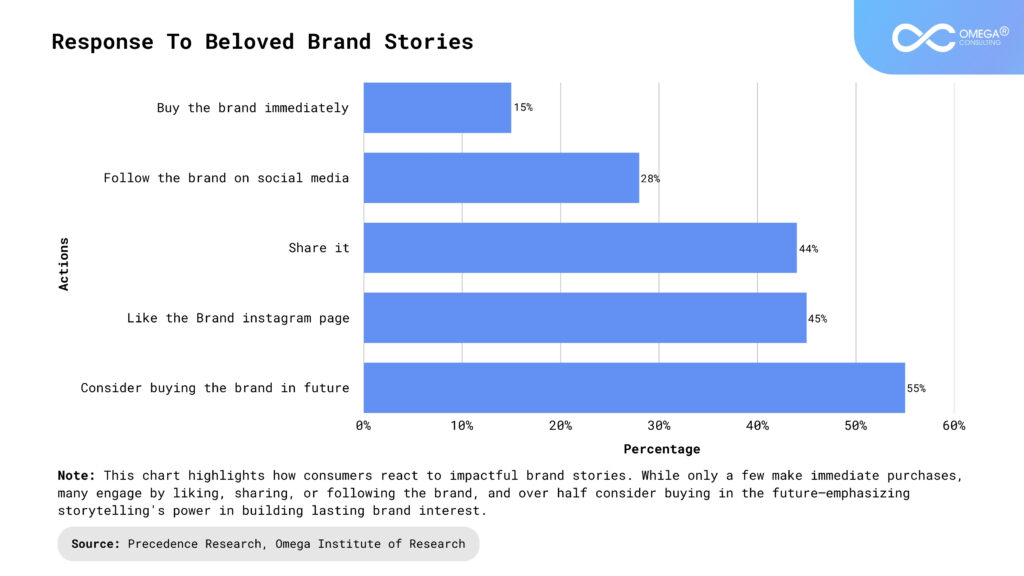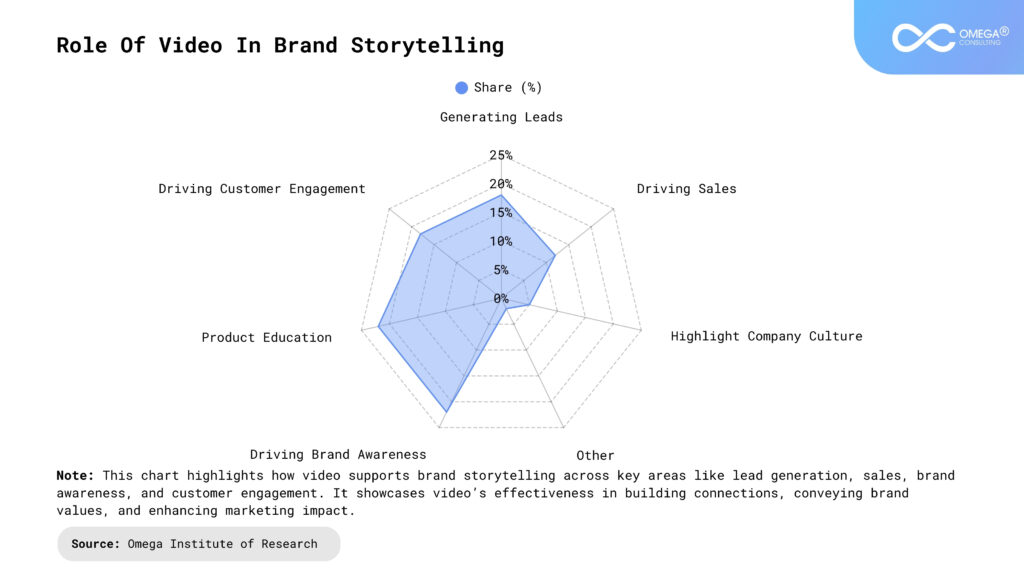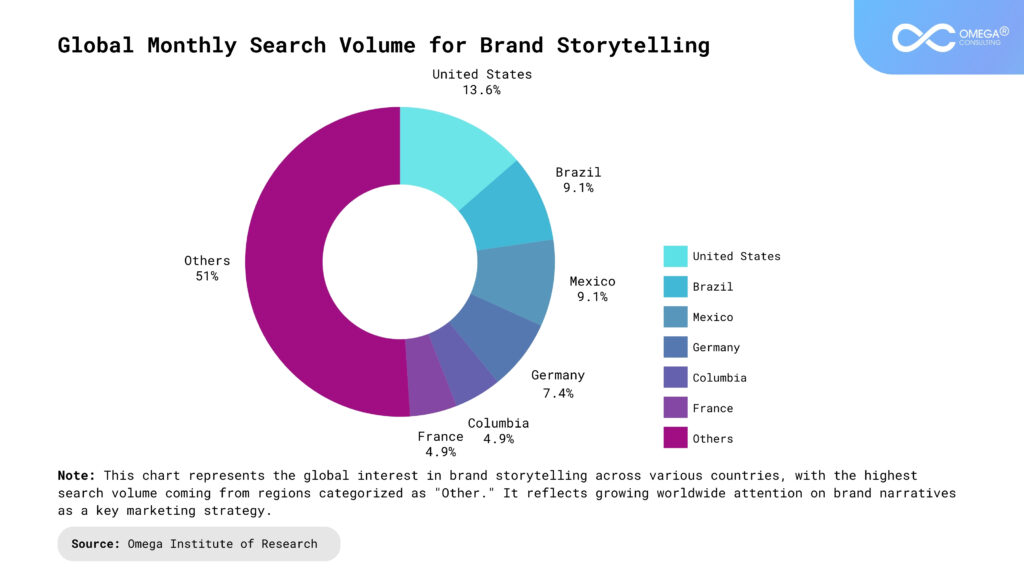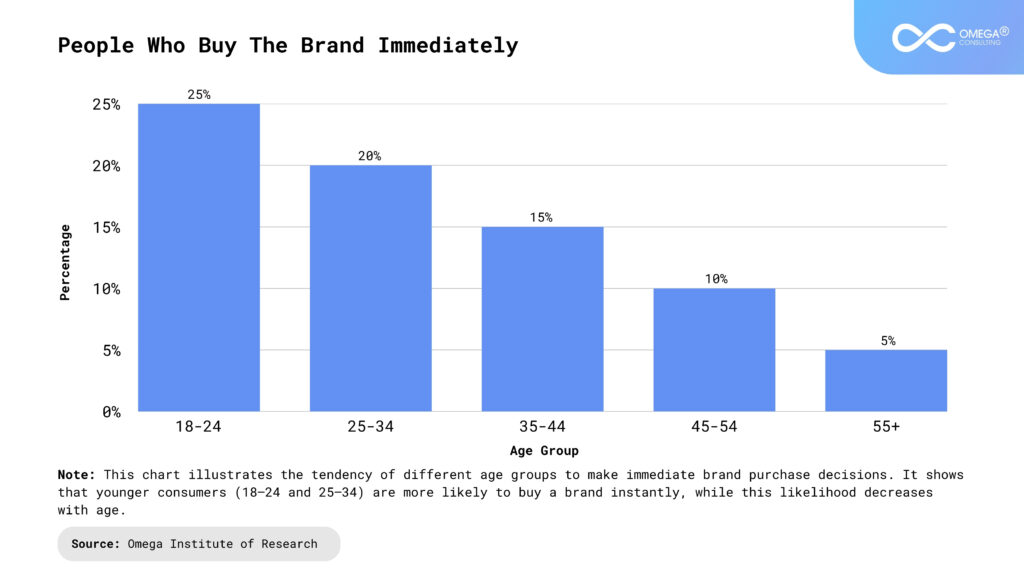- Industries
Industries
- Functions
Functions
- Insights
Insights
- Careers
Careers
- About Us
- Marketing & Advertising
- By Omega Team

A great story captures attention and leaves a lasting impact—storytelling has been a core part of the human experience since the beginning of time. Today, it’s not just novelists or filmmakers who tell powerful stories; some of the best storytellers are brands. Leading companies craft stories that sell, using compelling narratives alongside strong branding to develop attention-grabbing campaigns. A notable example is Dove’s Real Beauty campaign, which featured real people from around the world to challenge conventional beauty standards and promote self-love and acceptance. Its success lay in its authenticity, emotional appeal, and relevance to real-life issues. In a competitive market, strong brand storytelling is a powerful tool that builds loyalty, engagement, and differentiation. To succeed, brands must create content that is valuable, relatable, and emotionally resonant. This article explores how to harness storytelling to enhance your marketing strategy.
What is Brand Storytelling?
Brand storytelling centers around creating a narrative for your brand that customers can connect with. Knowing what your brand stands for will help guide your storytelling strategy and goals. Brand storytelling evokes a deep, emotional response, allowing customers to make personal connections. Using storytelling techniques in your marketing campaigns helps you effectively communicate core values, brand personality, and unique selling points. Effective brand storytelling sets your brand apart from competitors by creating a compelling story in an authentic and engaging manner. The ultimate goal of brand storytelling is to connect with your audience in a way that leads to a higher sense of brand loyalty and advocacy. Sharing stories that are relatable, inspiring, and consistent can help your brand build lasting relationships with your target audience. Brand storytelling is especially important for businesses looking to differentiate themselves in a crowded marketplace, increase engagement and retention, and enhance their reputation.

The Benefits of Brand Storytelling Important
Connecting with Customers: Brand storytelling helps build emotional connections through authenticity. By sharing real, relatable stories, businesses can humanize their brand, putting a face behind the product or service. This helps customers see the values and mission behind the brand and feel that their experiences and challenges are understood.
Building Trust and Loyalty: Stories that align with customer values foster a sense of shared purpose. When customers see themselves reflected in your brand’s message, they’re more likely to trust you and remain loyal. Authentic storytelling also enhances credibility by showcasing real successes and capabilities, leaving a lasting impression and reinforcing brand reliability.
Differentiating Your Brand: In crowded markets, brand storytelling helps you stand out by highlighting your unique identity, values, and history. A consistent and creative narrative can make your brand more memorable. Instead of relying solely on traditional marketing, brands should use innovative storytelling to communicate their message in engaging and distinctive ways.
Building Emotional Connections: Emotional storytelling taps into a wide range of feelings, empathy, inspiration, and relatability to create deeper audience engagement. Whether it’s a moving story of hardship or a light-hearted, relatable moment, genuine stories resonate more strongly and help brands forge long-term emotional bonds with customers.Elements of Brand Storytelling
Authenticity: Authenticity is the foundation of effective brand storytelling. Your story must be genuine and reflect your brand’s true values, mission, and vision. Today’s consumers are highly perceptive and can easily identify content that feels staged or insincere. When a brand shares honest experiences like the struggles it faced and how it overcame them it creates a sense of trust and relatability. Authentic storytelling helps humanize your brand and shows that it stands for something real and meaningful.
Relatability: For a story to resonate, your audience must see themselves in it. Relatable storytelling connects with the personal experiences, challenges, and aspirations of your target market. To achieve this, it’s important to understand your audience’s demographics, lifestyle, values, and pain points. When a story mirrors the everyday experiences or emotions of your audience, it fosters a sense of belonging and encourages long-term engagement with your brand.
Emotional Connection: Emotions drive decision-making. A powerful brand story taps into specific feelings like happiness, hope, empathy, or nostalgia to leave a lasting impression. Emotional connections not only make your content more memorable but also inspire people to take action, whether it’s purchasing, sharing, or advocating for your brand. Successful brands, such as Dove, use emotion-driven campaigns to address societal issues and connect on a human level, sparking conversation and loyalty.
Simplicity: In a noisy digital world, clear and concise storytelling stands out. Your brand’s message should be easy to understand and free from jargon or complexity. A simple narrative helps audiences quickly grasp your core message and makes it easier for them to retell or share it. Focus on one compelling theme or idea that reflects your brand’s identity and purpose, and communicate it in a straightforward, engaging way.
Consistency: Consistency ensures that your brand story is recognized and trusted across all channels and customer touchpoints. Whether it’s your social media, website, ads, packaging, or customer service, the tone, values, and message of your story should remain uniform. This reinforces your brand identity and builds familiarity over time. Coca-Cola, for instance, has consistently communicated a message of happiness and togetherness, making its story instantly recognizable across generations and markets.

Different types of Brand Story
Functional Brand Stories: These stories emphasize a brand’s product benefits, features, or problem-solving capabilities. They focus on delivering tangible value by addressing specific customer pain points that competitors might ignore. Functional stories are rooted in what makes the product or service better, faster, easier, or more efficient than alternatives. Example: Turkish apparel brand Mavi introduced a broader range of jean sizes and lengths—something its competitors lacked. This practical solution to a common customer issue led to its brand story focusing on the idea of a “Perfect Fit.” By showcasing how the brand listens to and acts on real customer needs, it positions itself as a thoughtful, responsive choice.
Underdog Brand Stories: Underdog stories highlight a brand’s journey from humble beginnings to hard-won success, often in the face of larger, more resource-rich competitors. These stories are compelling because many customers emotionally resonate with themes of struggle, passion, and perseverance. They typically include the founder’s story, early challenges, and key breakthroughs, making the brand feel more human and relatable.Example: Nantucket Nectars began with two college friends selling drinks from a floating store. Their label tagline, “With only a blender and a dream,” reflected their grassroots beginnings and determination. Consumers naturally root for the underdog, and this narrative builds emotional loyalty and long-term connection.
Lifestyle Brand Stories: Lifestyle stories connect the brand to a broader way of living, values, or aspirations. These stories aren’t just about products, they’re about the identity and lifestyle a customer adopts when they engage with the brand. They are especially powerful for emotion-driven purchasing and can help brands expand across cultures and markets by tapping into shared aspirations. Example: Mavi’s “Maviterranean” brand campaign embodied the stylish, easygoing, and confident Mediterranean lifestyle. By positioning itself not just as a clothing brand but a lifestyle choice, Mavi created an emotional appeal that transcended borders.
Celebrity Brand Stories & Influencer Collaborations: These stories gain traction by leveraging the trust, reach, and personality of celebrities or influencers. Celebrities help build brand credibility through association, while influencers personalize the brand story in a way that feels authentic and relatable to their followers. This method is especially impactful on social media platforms where followers engage closely with influencer content.Example: Gymshark’s “Gymshark66” campaign encouraged customers to build healthy habits over 66 days. The brand collaborated with fitness influencers, called Gymshark Athletes, who shared personal journeys and progress using the brand’s app and gear. These stories inspired followers, made the brand feel more accessible, and drove user-generated content.
Social Mission Brand Stories: These stories revolve around a brand’s commitment to social good, activism, or meaningful causes, aligning the brand with a larger purpose. When done authentically, they build trust and emotional bonds with customers who care about those same values. This approach strengthens brand identity and fosters advocacy beyond just the product. Example: Dove’s “Real Beauty Pledge” tackled societal beauty standards by featuring real women instead of models. The campaign promoted self-acceptance and diversity, challenging stereotypes and creating an emotional connection with audiences worldwide. Dove didn’t just sell products—it stood for something, which deeply resonated with its customers.
Understand your audience: The very first thing you’ll need to do is identify your target audience and understand exactly what their needs, wants, preferences and values are. This is a vital step to ensuring the messaging and story you use are not only appropriate for them, but that they will relate to and resonate with it. Research their demographics, behaviors and pain points and tailor your story to suit this.

Steps to Build and Engaging Brand Story
Define your brand’s identity: If you’ve not done it already, now is a great time to clearly define your brand’s missions, values and unique selling points. What makes you different from everyone else in the market? Why should people come to you? Determine what it is that sets you apart and how you want to be perceived by your customers.
Craft a core message: Once you’ve got your identity in the bag, it’s time to start thinking of the actual message of your story. This will be the foundation of your brand story and guide all storytelling efforts, so it’s worth putting a fair amount of research into this. It may be a good idea to hold focus groups or interviews with sections of your audience to see what kind of messages resonate with them the most.
Create a narrative arc: Your narrative will need to have a clear structure that includes elements such as exposition, conflict, climax and resolution. You want to take the audience on a journey, no matter how long or short your story is.
Identify the key characters: Introduce relatable and engaging characters that embody your brand’s values and connect with your customers. You’ll need a hero to your story, someone who goes through some sort of transformation. Someone for your audience to root for!
Incorporate visual and verbal elements: Video is an excellent way to engage with your audience, bringing together visual elements to complement the brand story and build on your brand voice. It’ll help take your audience on a journey with you by bringing your story to life with characters and narratives that play out the story in a most authentic and relatable way. Accompanied by a range of multimedia effects like sounds, visuals and text – you can make sure your audience stays engaged.
Show transformation and growth: There is nothing people like more than a happy ending. Your brand story is a great opportunity to show how people can benefit from using your product and being part of your brand, using it to overcome challenges and have a positive impact on the world around them.
Add a call to action: As much as this is all about storytelling, there’s no point in doing all this work if your audience doesn’t know what to do with your message. Lead them clearly to an action, whether that’s visiting your website, signing up to your mailing list or purchasing your product.
Test and refine: Share your brand story with a small test audience initially to gather feedback and make any necessary changes before going live. This will help you bring your point home by learning what works, and what doesn’t in the market.
Evolve: Remember that your brand story isn’t static – it should evolve with your brand’s growth and changing market dynamics. Take time to review your story each year to ensure it’s still relevant for your audience.
Examples of Brand Storytelling
Airbnb: Airbnb leverages data storytelling to enhance trust and personalize user experiences. By analyzing host and guest interactions, local market trends, and current events, Airbnb offers real-time recommendations. For instance, their “Price Tip” feature advises hosts on optimal pricing by predicting booking likelihood at various price points. Additionally, Airbnb shares compelling stories of its hosts, showcasing unique accommodations and experiences, which fosters a sense of community and authenticity
Spotify Wrapped: Spotify’s annual “Wrapped” campaign provides users with personalized insights into their listening habits over the past year, including top artists, genres, and total minutes streamed. This data-driven approach not only engages users by reflecting their personal music journeys but also encourages widespread sharing on social media, effectively turning users into brand ambassadors. The campaign’s success is evident, with significant increases in shares and app downloads during its release.
Google’s Year in Search: Google’s “Year in Search” compiles and presents the year’s most popular search queries, offering a reflective look at global events and trends. By transforming vast amounts of search data into a cohesive narrative, Google humanizes the data, making it relatable and engaging. For instance, the 2022 edition highlighted themes of healing and moving forward, resonating with audiences worldwide.
McKinsey & Company: As a global management consulting firm, McKinsey utilizes data storytelling to present complex industry insights in an accessible manner. Through detailed reports and visualizations, they translate intricate data into clear narratives, aiding businesses in understanding market dynamics and making informed decisions. This approach not only showcases McKinsey’s expertise but also builds trust with their clientele.
The BBC: The British Broadcasting Corporation (BBC) employs data storytelling to enrich its news reporting. By integrating data visualizations and interactive content, the BBC provides audiences with deeper insights into complex topics, enhancing comprehension and engagement. This method allows the BBC to present nuanced stories that resonate with a diverse audience
Future of Brand Storytelling
Interactive Storytelling: Technologies like augmented reality (AR) and virtual reality (VR) are enabling more immersive and interactive storytelling experiences. Brands can create virtual worlds and interactive narratives that engage audiences in entirely new ways.
User-Generated Content: Encouraging customers to share their own stories can amplify your brand’s narrative. User-generated content adds authenticity and creates a sense of community around your brand.
Data-Driven Storytelling: Leveraging data analytics to personalize stories can enhance their relevance and impact. Understanding individual customer preferences and behaviors allows brands to craft tailored narratives that resonate on a personal level.
Sustainability And Social Responsibility: Consumers are increasingly valuing brands that prioritize sustainability and social responsibility. Stories that highlight a brand’s efforts in these areas can build trust and loyalty.
Conclusion
Many consumers view their purchases—and the brands they support—as extensions of their identities and values. They want to feel like they are part of a community with which they share certain ideals.This is why you must define your brand story and reinforce it via brand story marketing. That way, your brand will spring to your target audience’s minds before your competition does. Your brand story must run through your content marketing. Whether it’s on your website, a blog, or social media channels, stick to that story, as well as your tone of voice. Brand storytelling is one of the best ways to differentiate your brand, establish an emotional connection with your target audience, and build a base of lasting customers.
- https://www.forbes.com/councils/forbescommunicationscouncil/2024/08/05/the-power-of-storytelling-in-modern-marketing/
- https://mailchimp.com/resources/brand-storytelling/
- https://www.outbrain.com/blog/brand-storytelling/
- https://online.hbs.edu/blog/post/brand-story
- https://playplay.com/blog/brand-storytelling/
- https://www.gwi.com/blog/brand-storytelling
- https://www.semrush.com/blog/definitive-guide-to-brand-storytelling/
- https://leapmesh.com/storytelling-marketing-statistics/
Subscribe
Select topics and stay current with our latest insights
- Functions